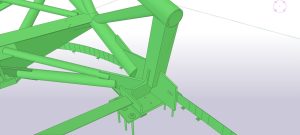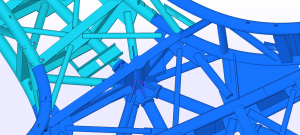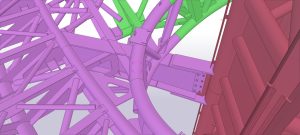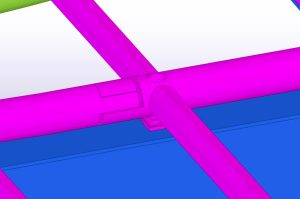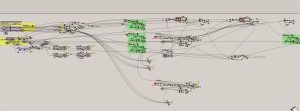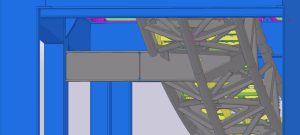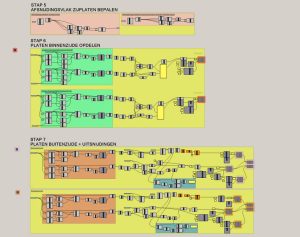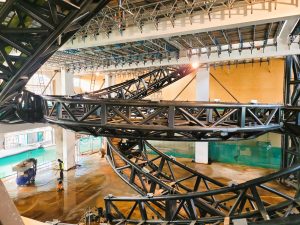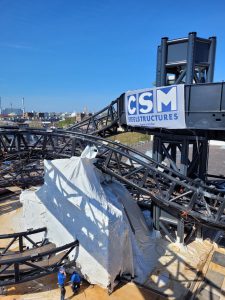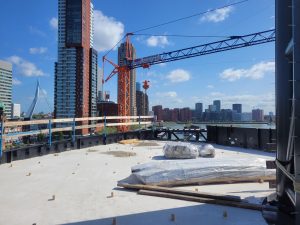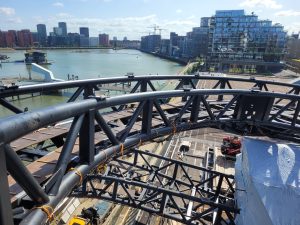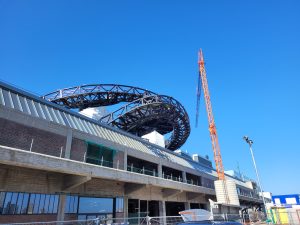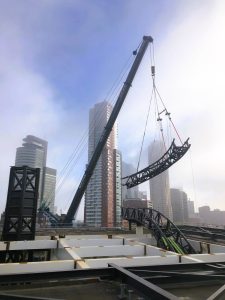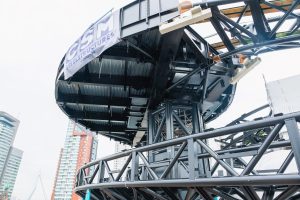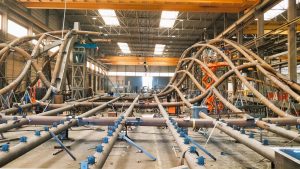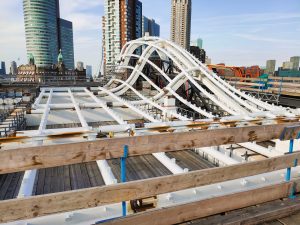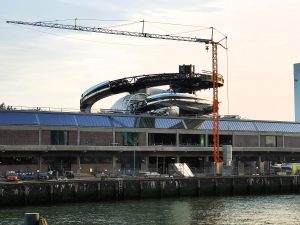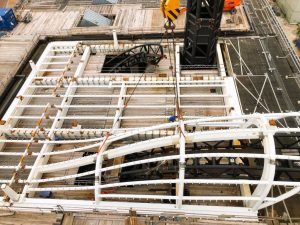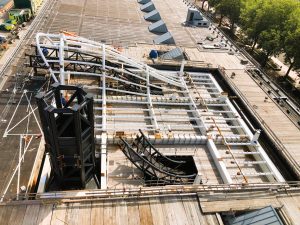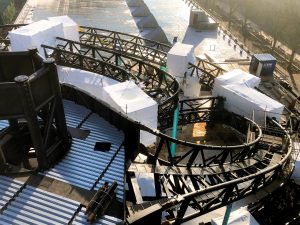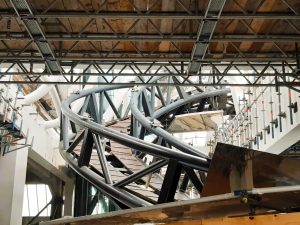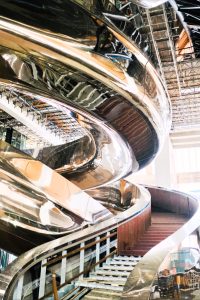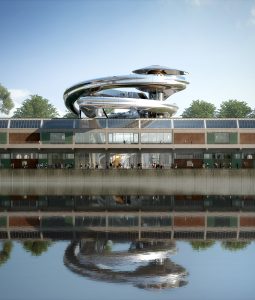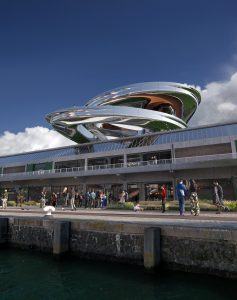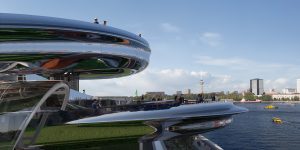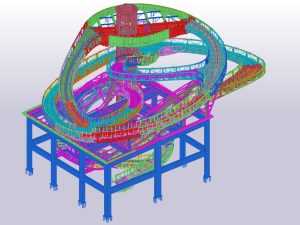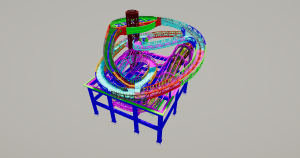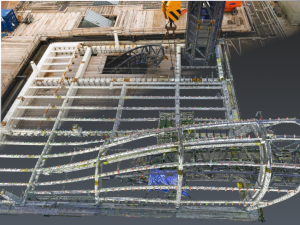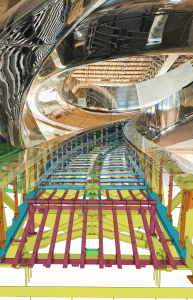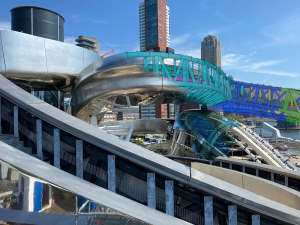 Winnaar van categorie in de landen:
Winnaar van categorie in de landen:
FENIX
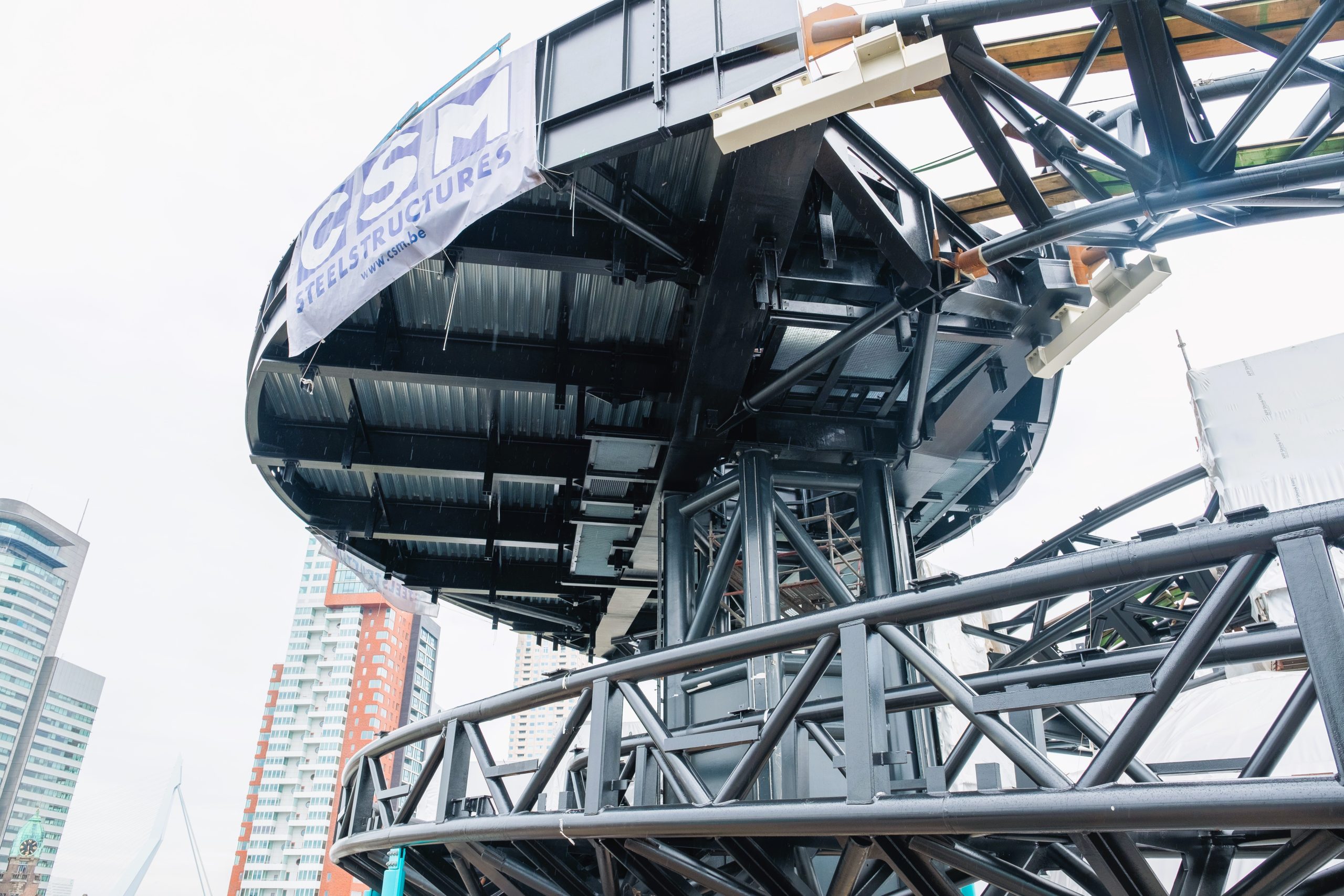
| Categorie | Publieke projecten |
|---|---|
| Jaar | 2024 |
| Land | Benelux |
| Organisatie | CSM Steelstructures |
| Projectpartners | IMd Raadgevende Ingenieurs - CIG Architecture - IFS Building Systems - Woodwave - Bosman - MAD Architects - EGM Architecten |
| Auteur | Lisa Luys |
| Co-auteurs | FENIX |
| Cliënt | Droom en Daad |
| Plaats van constructie | Rotterdam |
| Tags | Parametric designPointcloudsInterfaceTekla StructuresTrimble ConnectSteel |
Bij de opening in 1923 was de San Fransiscoloods te Rotterdam met zijn lengte van 360m de grootste op- en overslagloods van de wereld. Nadat in 1948 een brand in het midden van het gebouw de loods definitief in tweeën deelde, herrezen de ondertussen iconische FENIX I en FENIX II. In deze laatste zal de Stichting Droom en Daad het nieuwe FENIX Migratiemuseum onderbrengen.
Ter plaatse van de lobby van het museum zal de Tornado, een dubbele trap met een uitkijkplatform die doorheen het gebouw wervelt en boven het dak uitstijgt, een nieuwe landmark aan de kade worden. Deze Tornado is ontworpen door het Chinese architectenbureau MAD Architects op basis van een schets van Ma Yansong. De keuze voor een Chinese architect is tweeledig. De architectuur van MAD is organisch van vorm en is daarmee een toevoeging aan het vrij hoekige profiel van de skyline van Rotterdam. Anderzijds is het de eerste keer dat een Chinese architect een museumgebouw in Europa realiseert en is er een verwijzing naar het feit dat de wijk Katendrecht, waar het museum gevestigd is, één van de eerste Chinatowns van Europa was.
De constructie bestaat uit 2 omwentelende trappen die oprijzen vanuit de grond en uitmonden in een uitkijkplatform op de top. De trappen brengen verschillende ritmes in de ruimte, waardoor de imposante schaal van de loods wordt doorbroken en er meer menselijke schaal en intieme ruimtes ontstaan. Vervaardigd uit (roestvrij) staal en hout, contrasteren de materialen sterk met het oorspronkelijke beton en staal van de loods, terwijl ze tegelijkertijd bezoekers aanzetten om zich het inschepen op een schip voor te stellen.
Meer dan een renovatie
Doorheen het project is er een schril contrast tussen het statige, betonnen gebouw enerzijds en de organische, stalen Tornado anderzijds. Daar waar het pand gerenoveerd wordt om terug de grandeur van vroeger te laten stralen, wordt voor de Tornado resoluut het tegengestelde betoogd.
Voor beide onderdelen staat echter de eis naar een hoog afwerkingsniveau centraal. Een naadloze overgang tussen de Tornado en het gebouw is daarom cruciaal. Hiertoe zijn er in de beginfase meerdere scans genomen van de bestaande structuur om zodanig de overgangen op de verschillende niveaus goed in kaart te kunnen brengen. Deze scans werden ook als referentie meegenomen in het BIM Model. Ter plaatse van die overgangen dient ten alle tijden de nodige dilataties gerespecteerd te worden zonder dat deze te zichtbaar zijn.
Constructief samenspel
Door de combinatie van een oude betonnen loods en een nieuwe stalen structuur, is er uitzonderlijke aandacht nodig voor de ontkoppelingen. Zo is er een nieuwe stalen tafelconstructie gemaakt (lobbybox), die de Tornado draagt. Op deze staalconstructie wordt een glazen dak voorzien, met dubbel gekromde glaspanelen waarbij de positionering van die panelen gefinetuned is aan de hand van een pointcloud die vastgelegd is op de werf. Doorheen het glasdak zijn 3 openingen voorzien, enerzijds voor de liftkern en anderzijds voor de Tornado die via de 2 cockpits door het dak, via de liftkern, richting het uitkijkplatform gaat. De vele verschillende elementen in de constructie zijn dus gedilateerd, namelijk de bestaande loods, het glasdak, het spaceframe, de liftschacht, de huid rondom in RVS, de deuren,…
Heel veel verschillende partners dus die hun detaillering in één geheel moeten verwerken om alles tot een goed einde te brengen. Hierin heeft het hele BIM proces een belangrijk rol gespeeld. Het zorgde voor een intense samenwerking tussen zowel CSM, de staalconstructeur, EGM architecten, CIG, de RVS-bekledingsleverancier, Woodwave, de houtbekleder, Bosman voor de technieken en ook IFS, de glasconstructeur. Naast deze partners zijn er nog verschillende andere betrokken partijen geweest die stuk voor stuk beroep konden doen op een gedetailleerd BIM-model.
Staalcomplexiteit
Door de vele krommingen in de volledige constructie, de hoge eisen op esthetisch en constructief vlak én het samenkomen van verschillende disciplines in 1 staalstructuur is de complexiteit van het project groot. De combinatie van Grasshopper – Tekla was een cruciaal gegeven om het model op te bouwen maar ook om het haalbaar te maken voor productie. Met behulp van Grasshopper is er bijgevolg ook een algoritme ontwikkeld om een 3D-zeeg te induceren zodat de uiteindelijke vervormingen op de werf geminimaliseerd konden worden. Ook de controle van eventuele afwijkingen na het monteren werden aan de hand van inmetingen in Grasshopper gecontroleerd.
De staalconstructie van de wenteltrap bestaat uit een combinatie van plaatwerk, buizen en kokers. Het volledige spaceframe bevat maar liefst 2100 lopende meter gekromde buizen. Het glasdak bestaat dan weer uit gekromde buizen, met wanddiktes van 16 en 20mm. Voor de liftkern hebben de hoofdkolommen een diameter van 508mm, en bij het platform zijn er plaatdiktes tot 100mm dik gebruikt.
Om de impact op de omwonenden van het pand tot een minimum te beperken, is er steeds geopteerd om zo groot mogelijke onderdelen naar de bouwplaats te vervoeren. Dit resulteert bovendien in minder vrachten wat ook ecologisch de meest voor de hand liggende keuze is. Verder is getracht waar mogelijk ook het transport over water uit te voeren. Zo is bijvoorbeeld de liftkern en delen van het platform over het water naar de bouwplaats getransporteerd.
Niet enkel voor het modelleren van de constructie was het een hele opgave, ook het monteren bracht moeilijkheden met zich mee. Doordat er zoveel bochten en krommingen aanwezig zijn, was het onmogelijk om dit weer te geven op een 2D plan. Daarom is er gekozen om te werken met een tablet en verschillende modellen via Trimble Connect om het monteren mogelijk te maken. Op die manier zijn er ook vele papieren plannen uitgespaard.
Kortom, de complexe integratie van oud en nieuw in het FENIX-project vereist een zorgvuldige coördinatie tussen diverse partners. Dankzij intensieve samenwerking en geavanceerde technologieën waaronder BIM, zijn we in staat geweest om de uitdagingen van dit project aan te gaan en een iconisch resultaat te leveren. De Tornado, met zijn gedurfde ontwerp en innovatieve materialen, zal niet alleen dienen als een nieuwe blikvanger op de kade, maar ook als een symbool van de succesvolle samenwerking tussen creativiteit, vakmanschap en technologie.
When it opened in 1923, the San Fransisco warehouse in Rotterdam, with its length of 360m, was the largest storage and transshipment warehouse in the world. After a fire in the middle of the building in 1948 permanently split the warehouse in two, the now iconic FENIX I and FENIX II were resurrected. The latter will house the Droom en Daad Foundation’s new FENIX Migration Museum.
At the site of the museum’s lobby, the Tornado, a double staircase with a viewing platform that swirls through the building and rises above the roof, will become a new landmark on the wharf. This Tornado was designed by Chinese architecture company MAD Architects based on a sketch by Ma Yansong. The choice of a Chinese architect is twofold. MAD’s architecture is organic in form, adding to the rather angular profile of Rotterdam’s skyline. On the other hand, it is the first time a Chinese architect has realized a museum building in Europe and refers to the fact that the neighborhood of Katendrecht, where the museum is located, was one of the first Chinatowns in Europe.
The structure consists of 2 revolving staircases that rise from the ground and culminate in a viewing platform at the top. The stairs bring different rhythms to the space, breaking the imposing scale of the building and creating more human scale and intimate spaces. Made of (stainless) steel and wood, the materials strongly contrast with the original concrete and steel of the warehouse, while at the same time encouraging visitors to imagine embarking on a ship.
More than a renovation
Throughout the project, there is a sharp contrast between the stately, concrete building on the one hand and the organic, steel Tornado on the other. Where the building is being renovated to bring back the grandeur of the past, the Tornado resolutely argues the opposite.
For both areas, however, the requirement for a high level of finish is key. A seamless transition between the Tornado and the building is therefore crucial. To this end, several scans were taken of the existing structure during the initial phase in order to properly map the transitions at the various levels. These scans were also included as a reference in the BIM Model. At those transitions, the necessary dilations must be respected at all times without being too visible.
Constructive interaction
Due to the combination of an old concrete warehouse and a new steel structure, exceptional attention needed to be paid to decoupling. Thus, a new steel table structure was created (lobbybox), which carries the Tornado. On this steel structure, a glass roof is provided, with double-curved glass panels where the positioning of those panels was fine-tuned based on a pointcloud recorded on site. Throughout the glass roof, 3 openings are provided. One for the elevator core and the other two for the Tornado that passes through the roof through the 2 cockpits, passing the elevator shaft and finally heading towards the viewing platform. The many different elements in the construction are thus dilated, namely the existing warehouse, the glass roof, the spaceframe, the elevator shaft, the stainless steel skin, the doors, ….
So a lot of different partners who had to integrate their detailing into one to bring everything to a successful outcome. This is where the whole BIM process played an important role. It created an intense collaboration between both CSM, the steel constructor, EGM architects, CIG, the stainless steel skin supplier, Woodwave, the wood cladding contractor, Bosman for the installations and also IFS, the glass constructor. In addition to these partners, there were several other parties involved, each of whom had access to a detailed BIM model.
Steel complexity
Due to the many curves in the entire structure, the high demands in terms of aesthetics and construction and the convergence of different disciplines in 1 steel structure, the complexity of the project is high. The combination of Grasshopper – Tekla was crucial to build the model but also to make it producible. Consequently, using Grasshopper, an algorithm was also developed to induce a 3D precamber so that the final deformations on site could be minimized. Control of any deviations after assembly were also checked using Grasshopper.
The steel structure of the spiral staircase consists of a combination of sheet metal, circular tubes and rectangular tubes. The entire space frame contains as much as 2,100 running meters of curved tubes. In turn, the glass roof consists of curved tubes, with wall thicknesses of 16 and 20mm. For the elevator core, the main columns have a diameter of 508mm, and for the platform, sheet metal thicknesses up to 100mm thick have been used.
In order to minimize the impact on those living in the neighbourhood of the building, it was always opted to transport the largest possible components to the construction site. This also results in fewer freights, which is also the most obvious choice ecologically speaking. Furthermore, wherever possible, an attempt was also made to carry out transport by water. For example, the elevator core and parts of the platform were transported to the construction site across waterways.
Not only modelling the structure was a daunting task, the mounting also brought difficulties. With so many bends and curves present, it was impossible to represent this on a 2D plan. Therefore, the choice was made to work with a tablet and different models using Trimble Connect to be able to do the mounting. By doing so, many paper plans were also saved.
In short, the complex integration of the old and new in the FENIX project requires careful coordination between various partners. Thanks to intensive collaboration and advanced technologies including BIM, we were able to meet the challenges of this project and deliver an iconic result. The Tornado, with its bold design and innovative materials, will serve not only as a new eye-catcher on the wharf, but also as a symbol of the successful collaboration between creativity, craftsmanship and technology.
